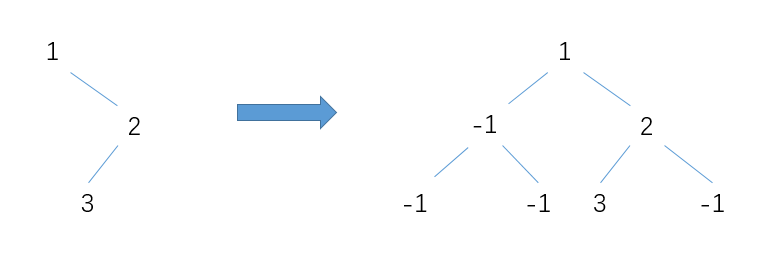111. Minimum Depth of Binary Tree
Given a binary tree, find its minimum depth.
The minimum depth is the number of nodes along the shortest path from the root node down to the nearest leaf node.
Note: A leaf is a node with no children.
Example:
Given binary tree [3,9,20,null,null,15,7],
3
/ \
9 20
/ \
15 7
return its minimum depth = 2.
求一棵二叉树的最小深度,类似于LeetCode Maximum Depth of Binary Tree求最大深度,但是稍微难一点。 请注意,不能直接把求最大深度的大于号改为小于号:
class Solution {
public:
int dfs(TreeNode* root, int nDepth)
{
if (root == NULL)
return nDepth;
int left = dfs(root->left, nDepth + 1);
int right = dfs(root->right, nDepth + 1);
return left < right ? left : right;
}
int minDepth(TreeNode* root) { return dfs(root, 0); }
};
因为如上图所示,当走到A点时,没有右孩子,导致int right = dfs(root->right, nDepth + 1);会得到A点的高度2,比左孩子的高度低,即最小高度为2了。但是最小高度显然是4。所以需要稍加修改,使得如果某个孩子为空时,不在该孩子深搜了,只有当两个孩子都为空时(即是叶子节点时),才得到一个合法的深度,去和其他深度做比较。
深度搜索的完整代码如下:
class Solution {
public:
int dfs(TreeNode* root, int nDepth)
{
if (root == NULL)
return nDepth;
if (root->left == NULL && root->right == NULL)
return nDepth + 1;
int left = root->left == NULL ? INT_MAX : dfs(root->left, nDepth + 1);
int right = root->right == NULL ? INT_MAX : dfs(root->right, nDepth + 1);
return left < right ? left : right;
}
int minDepth(TreeNode* root) { return dfs(root, 0); }
};本代码提交AC,用时9MS。
但是DFS必须走到所有叶子节点才能得到最小深度,而如果采用广度优先搜索BFS时,遇到的第一个叶子节点的深度就是最小深度了,就可以返回了。所以理论上,BFS的性能会更优。
BFS的完整代码如下:
struct NewTreeNode {
TreeNode* tn;
int depth;
};
class Solution {
public:
int bfs(TreeNode* root)
{
queue<NewTreeNode*> qTree;
NewTreeNode* ntn = new NewTreeNode;
ntn->tn = root;
ntn->depth = 0;
qTree.push(ntn);
NewTreeNode* top = new NewTreeNode;
while (!qTree.empty()) {
top = qTree.front();
qTree.pop();
if (top->tn == NULL)
return top->depth;
if (top->tn->left == NULL && top->tn->right == NULL)
return top->depth + 1;
if (top->tn->left != NULL) {
NewTreeNode* tmp = new NewTreeNode;
tmp->tn = top->tn->left;
tmp->depth = top->depth + 1;
qTree.push(tmp);
}
if (top->tn->right != NULL) {
NewTreeNode* tmp = new NewTreeNode;
tmp->tn = top->tn->right;
tmp->depth = top->depth + 1;
qTree.push(tmp);
}
}
return -1;
}
int minDepth(TreeNode* root) { return bfs(root); }
};本代码提交AC,用时也是9MS。
我看Leetcode上有很多关于树的题,为了方便测试,自己写了一个由数组构造树结构的函数,如下:
#include <vector>
using namespace std;
// Definition for a binary tree node.
struct TreeNode {
int val;
TreeNode* left;
TreeNode* right;
TreeNode(int x)
: val(x)
, left(NULL)
, right(NULL)
{
}
};
TreeNode* genTree(vector<int>& vi, int id)
{
if (vi.size() == 0)
return NULL;
TreeNode* root = new TreeNode(vi[id]);
if (2 * id + 1 < vi.size() && vi[2 * id + 1] != -1) {
root->left = genTree(vi, 2 * id + 1);
}
if (2 * id + 2 < vi.size() && vi[2 * id + 2] != -1) {
root->right = genTree(vi, 2 * id + 2);
}
return root;
}
int main()
{
vector<int> vTree = { 1, 2, 3, 4, 5 };
TreeNode* root = genTree(vTree, 0);
return 0;
}
使用时只要传入数组和0,返回的就是一个建好的树。用数组存树,一般第i号节点的左右孩子下标分别为2i+1和2i+2。存好之后恰好是一棵树的层次遍历结果。
如果要构建的不是一棵完全树,比如下面的左图,则先需要转换为完全图,也就是用-1代替一个不存在的节点,此时传入的数组应该是[1,-1,2,-1,-1,3,-1],genTree函数遇到-1会自动跳过不创建节点。当然如果你的树中本来就有-1这个值,也可以把-1换成其他数。
二刷。BFS的代码还可以写得更简洁漂亮一些,类似于层次遍历,遍历到某一层有叶子节点时,层数就是最小深度,代码如下:
class Solution {
public:
int minDepth(TreeNode* root)
{
if (root == NULL)
return 0;
int depth = 0;
queue<TreeNode*> q;
q.push(root);
while (!q.empty()) {
++depth;
int n = q.size();
while (n--) {
TreeNode* cur = q.front();
q.pop();
if (cur->left == NULL && cur->right == NULL)
return depth;
if (cur->left != NULL)
q.push(cur->left);
if (cur->right != NULL)
q.push(cur->right);
}
}
return depth;
}
};本代码提交AC,用时9MS。
DFS的代码也可以写得更漂亮一些:
class Solution {
public:
int minDepth(TreeNode* root)
{
if (root == NULL)
return 0;
if (root->left == NULL)
return minDepth(root->right) + 1;
if (root->right == NULL)
return minDepth(root->left) + 1;
return min(minDepth(root->left), minDepth(root->right)) + 1;
}
};本代码提交AC,用时13MS,比BFS慢。
Pingback: LeetCode Binary Tree Inorder Traversal | bitJoy > code
Pingback: LeetCode Linked List in Binary Tree | bitJoy > code
Pingback: LeetCode Serialize and Deserialize Binary Tree | bitJoy > code